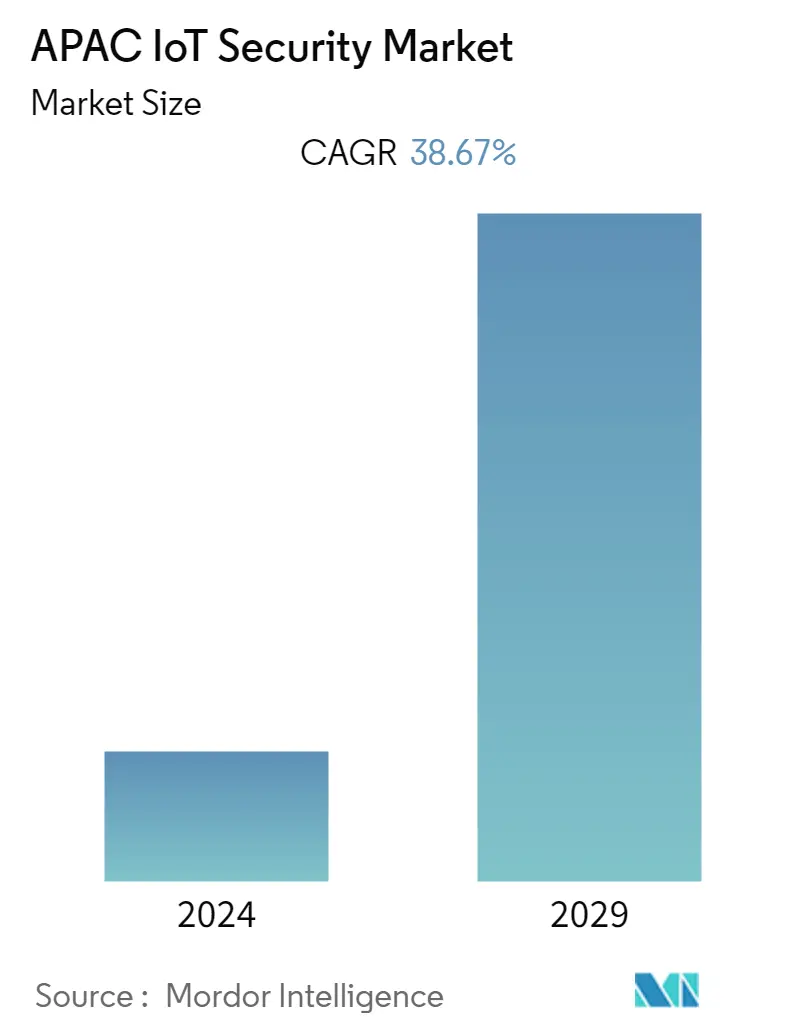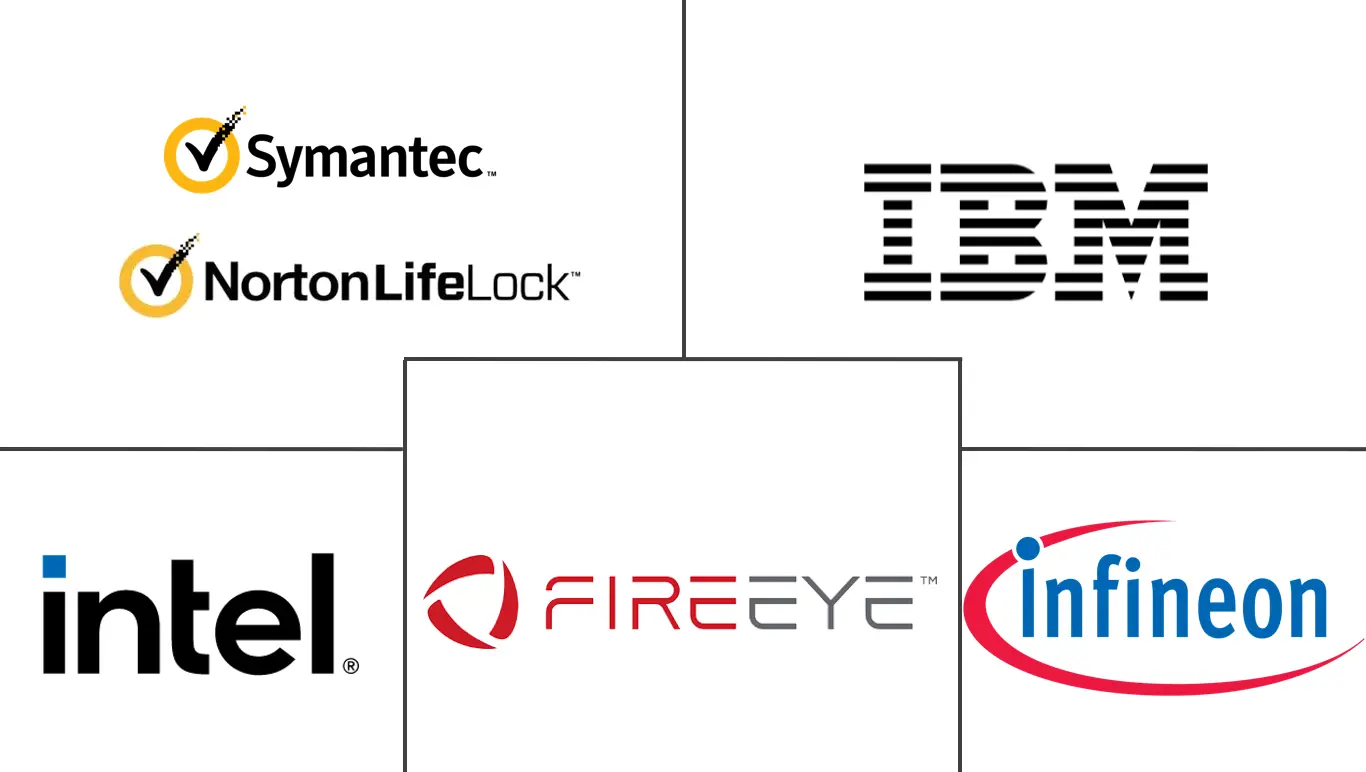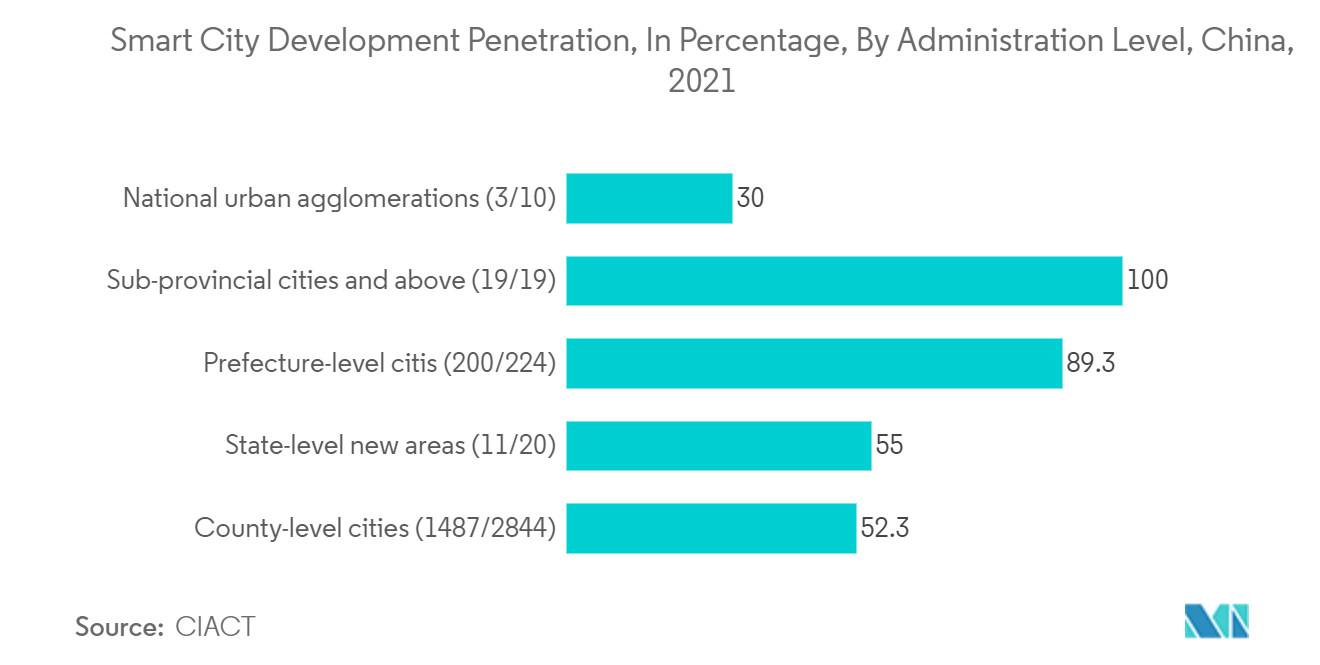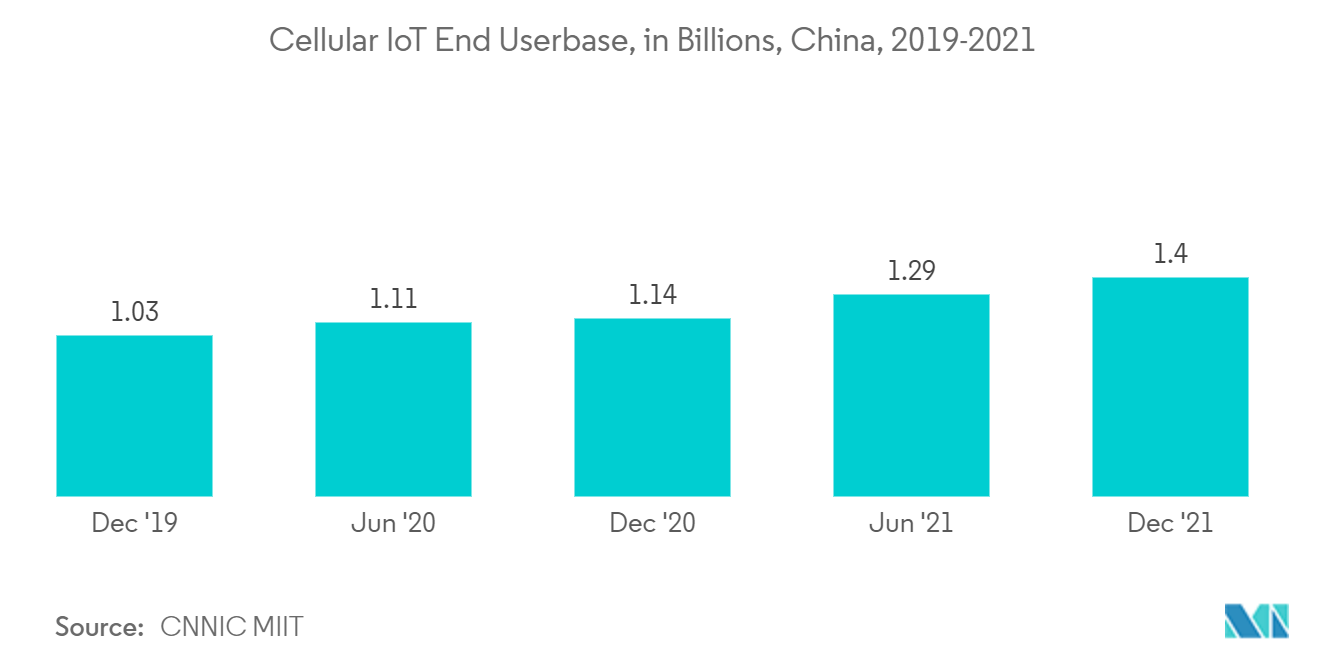APAC IoT Security Market Size

| Study Period | 2021 - 2029 |
| Base Year For Estimation | 2023 |
| Forecast Data Period | 2024 - 2029 |
| Historical Data Period | 2021 - 2022 |
| CAGR | 38.67 % |
| Market Concentration | Low |
Major Players
*Disclaimer: Major Players sorted in no particular order |
APAC IoT Security Market Analysis
The Asia-Pacific Internet of Things (IoT) Security Market has registered a CAGR of 38.67% during the forecast period. COVID-19 played a significant role in giving rise to the work-from-home concept, increasing the demand for IoT security solutions to improve safety and provide real-time monitoring to bring transparency. The market is growing because there are more ransomware attacks on different IoT devices and more IoT security regulations in the developing economies in the region. Malware and phishing attacks on different businesses are also helping the market grow.
- The Asia-Pacific region has surfaced as a manufacturing hub, owing to the low production costs in emerging countries such as India and China, which remain a significant market in Asia Pacific's IoT security market. Investments are being planned for the quality of growth, addressing environmental concerns, and reducing overcapacity. The region's automotive industry has emerged as one of the world's largest and is expected to grow further over the next five years.
- India is the fastest-growing economy in the world, and generating enough energy is the key to achieving developmental ambitions that support expansion. The country is regarded as a newly industrialized landscape, becoming a preferred manufacturing hub. India is far superior to many nations in manufacturing medical drugs and products.
- Cyber attackers took advantage of the conditions created by the COVID-19 pandemic in the region and targeted sectors like hospitals, medical and pharmaceutical manufacturers, and other companies. According to the latest IBM X-Force Threat Intelligence Index report, Asia saw a high volume of attacks on finance and insurance organizations last year, accounting for 34% of all attacks on this industry.
- APAC is one of the fastest-growing regions in digital transformation and internet penetration and has experienced exponential growth in financial technology and e-commerce, resulting in a rising demand for Internet and broadband services. This change has brought many benefits and has a lot of potential for the future, but it has also opened the door to a large number of cybersecurity threats, which is driving the growth of the market.
- The rise in connectivity between companies in the region has exposed vulnerabilities in hardware and software environments, giving cybercriminals greater attack surfaces to exploit. This includes employees' smaller, personal IoT devices, which can provide a potential backdoor into more well-protected systems. Further, several countries have attempted to impose data protection and breach notification laws. However, as a whole, cybersecurity regulation in Asia-Pacific is still in the early phases of development and tends to focus mainly on critical infrastructure and regulated industries.
APAC IoT Security Market Trends
This section covers the major market trends shaping the APAC IoT Security Market according to our research experts:
Emergence of Smart City and Smart Home Developments to Drive the Market Growth
Increasing government focus on smart cities, smart buildings, and Industry 4.0 initiatives is driving the demand for digital IoT solutions in the Asia-Pacific region, such as in public transportation, eGovernment, smart traffic management systems, and smart power grids. The integration of edge-computing networks with IoT systems and narrow-band (NB) IoT deployments, along with rising investments in 4G/LTE and 5G, reduced IoT sensor costs, and governmental support, are fueling the growth of the market in the region.
- 5G is expected to accelerate the adoption of smart home IoT devices in the region. Companies such as China Mobile International (CMI) are supporting the transition to 5G with a global digital infrastructure encompassing more than 70 international cables, including various self-built submarine cables and invested terrestrial cables, with a total network capacity of over 98 terabits per second. It also has more than 180 overseas points of presence on key continents, 340 data centers in China, and four data centers that it owns in key centers outside of China.
- Government investment in smart cities accounts for almost one-third of the region's combined spending, followed by logistics, transportation, and manufacturing. Various governments in the region are promoting the adoption of "smart cities." According to the Government Technology Agency, a statutory board of the Singapore government, in the last year, the Singapore government planned to spend 13% of their ICT spending on accelerating the adoption and deployment of Artificial Intelligence (AI) for the public sector and 70% on transforming, integrating, and streamlining digital services. The planned ICT spending for the last year was USD 2.8 billion.
- However, the resource-constrained nature of various IoT devices in a smart home environment, such as meters, thermostats, and entertainment units, does not permit the implementation of standardized security solutions. Therefore, smart homes are currently vulnerable to security threats.
Also, the rise of high-tech smart devices that store and share personal information poses a serious threat to people's privacy in the region. Existing privacy laws don't do enough to deal with this problem, which could slow the growth of the smart home market in the region as a whole.

China Witnesses Significant Growth Opportunities in the Market
- The significant factors for the growth of the IoT security market in China are the high adoption of advanced technologies, increasing cyberattacks, and a growing number of connected devices in the country. The country is one of the dominant regions for IoT deployment. Other factors include the growth of digitalization and IoT security spending in the region.
- The Chinese Ministry of Industry and Information Technology published guidelines for creating a security standard system for the Internet of Things. The guidance seeks to outline a framework that will promote public network security risk mitigation and prevention, along with developing and implementing standards for the IoT. MIIT has a list of standard requirements that includes things like software security, access authentication, and data security.
- Companies such as China Mobile International (CMI) are also building an ecosystem to help industry partners capitalize on the flourishing market for smart solutions, with an initial focus on elevating the smart home experience for consumers. CMI develops and delivers international data services and solutions that lay the foundation for the rapid growth of IoT across key markets. CMI has provided IoT solutions to over 100 enterprises in 20 countries and regions, primarily in Asia Pacific, as of October last year. This can promote IoT connectivity and eSIM platform integration, enhancing IoT network capabilities around the world.
- The Chinese government informed companies last September about increased cyber-data security oversight on connected vehicles. According to the Ministry of Industry and Information Technology, the companies were asked to establish data security management systems and regularly assess risks from network attacks.

APAC IoT Security Industry Overview
The Asia-Pacific Internet of Things (IoT) Security Market is fragmented with a few major players, such as Symantec Corporation, IBM Corporation, FireEye Inc., Intel Corporation, and Infineon Technologies, as well as various established international brands, domestic brands, and new entrants that form a competitive landscape. Some major players are increasingly seeking market expansion through strategic mergers and acquisitions, innovation, and increased investments in research and development.
In November 2022, Truvisor announced a partnership with Vectra AI, a security AI-driven hybrid cloud threat detection and response solution provider. The Vectra platform and services include public cloud, SaaS applications, identity systems, and on-premises and cloud-based network infrastructure. Through the partnership, the company would be able to sell its products and services through the resellers of Truvisor in Singapore, Indonesia, and Thailand.
APAC IoT Security Market Leaders
-
Symantec Corporation (NortonLifeLock Inc)
-
IBM Corporation
-
FireEye Inc.
-
Intel Corporation
-
Infineon Technologies
*Disclaimer: Major Players sorted in no particular order
_Security_Market_-_Market_Concentration.webp)
APAC IoT Security Market News
- August 2022 : Truvisor announced its partnership with One Identity, a unified identity security provider. The partnership would allow Truvisor to deliver One Identity solutions through their resellers' channels in Singapore, the Philippines, and Indonesia.
- April 2022 : Swimlane, a low-code security automation provider, announced the launch of Swimlane Cloud in the Asia-Pacific Japan (APJ) region. Swimlane's interactive dashboards and automated, easily customizable workflows reduce the mean time to respond and ultimately help organizations ensure continuous compliance and prevent breaches.
APAC IoT Security Market Report - Table of Contents
1. INTRODUCTION
- 1.1 Study Assumptions and Market Definition
- 1.2 Scope of the Study
2. RESEARCH METHODOLOGY
3. EXECUTIVE SUMMARY
4. MARKET INSIGHTS
- 4.1 Market Overview
- 4.2 Value Chain Analysis
-
4.3 Porter's Five Forces Analysis
- 4.3.1 Threat of New Entrants
- 4.3.2 Bargaining Power of Buyers
- 4.3.3 Bargaining Power of Suppliers
- 4.3.4 Threat of Substitutes
- 4.3.5 Intensity of Competitive Rivalry
- 4.4 Assessment of the Impact of COVID-19 on the Market
5. MARKET DYNAMICS
-
5.1 Market Drivers
- 5.1.1 Increasing Number of Data Breaches
- 5.1.2 Emergence of Smart Cities
-
5.2 Market Restraints
- 5.2.1 Growing Complexity among Devices, coupled with the Lack of Ubiquitous Legislation
6. MARKET SEGMENTATION
-
6.1 Type of Security
- 6.1.1 Network Security
- 6.1.2 Endpoint Security
- 6.1.3 Application Security
- 6.1.4 Cloud Security
- 6.1.5 Other types of security
-
6.2 Solutions
- 6.2.1 Identity Access Management (IAM)
- 6.2.2 Intrusion Prevention System (IPS)
- 6.2.3 Data Loss Protection (DLP)
- 6.2.4 Unified Threat Management (UTM)
- 6.2.5 Security & Vulnerability Management (SVM)
- 6.2.6 Network Security Forensics (NSF)
- 6.2.7 Other solutions
-
6.3 Applications
- 6.3.1 Home Automation
- 6.3.2 Wearables
- 6.3.3 Manufacturing Process Management
- 6.3.4 Patient Information Management
- 6.3.5 Supply Chain Operation
- 6.3.6 Customer Information Security
- 6.3.7 Other applications
-
6.4 End-User Verticals
- 6.4.1 Healthcare
- 6.4.2 Manufacturing
- 6.4.3 Utilities
- 6.4.4 BFSI
- 6.4.5 Retail
- 6.4.6 Government
- 6.4.7 Other end-user verticals
-
6.5 Geography
- 6.5.1 China
- 6.5.2 India
- 6.5.3 Japan
- 6.5.4 Other countries
7. COMPETITIVE LANDSCAPE
-
7.1 Company Profiles
- 7.1.1 Symantec Corporation (NortonLifeLock Inc)
- 7.1.2 IBM Corporation
- 7.1.3 FireEye Inc.
- 7.1.4 Intel Corporation
- 7.1.5 Infineon Technologies
- 7.1.6 Trend Micro Inc.
- 7.1.7 Sophos Group PLC
- 7.1.8 ARM Holdings PLC
- 7.1.9 Wurldtech Security Technologies Inc.
- 7.1.10 Gemalto NV
- *List Not Exhaustive
8. INVESTMENT ANALYSIS
9. FUTURE OF THE MARKET
** Subject To AvailablityAPAC IoT Security Industry Segmentation
IoT security is a technological solution for safeguarding networks and connected mechanical or digital devices. These solutions aim to eradicate vulnerabilities and equip devices to identify, resist and recover from cyber-attacks. IoT security comprises various smart solutions, such as device authentication and management, secure connections, and data loss prevention. These solutions, integrated with IoT devices, provide real-time protection from threats.
IoT security solutions can secure Internet devices and the networks they're connected to from threats and breaches by protecting, identifying, and monitoring risks while helping fix vulnerabilities from various devices that can pose security risks to a business.
Asia Pacific IoT security market is segmented by type of security (Network Security, Endpoint Security, Application Security, Cloud Security), by Solutions (Identity Access Management (IAM), Intrusion Prevention System (IPS), Data Loss Protection (DLP), Unified Threat Management (UTM), Security & Vulnerability Management (SVM), Network Security Forensics (NSF)), by Applications (Home Automation, Wearables, Manufacturing Process Management, Patient Information Management, Supply Chain Operation, Customer Information Security), End-User Industries (Healthcare, Manufacturing, Utilities, BFSI, Retail, Government), and Geography.
The market sizes and forecasts are provided in terms of value (in USD million) for all the above segments.
| Type of Security | Network Security |
| Endpoint Security | |
| Application Security | |
| Cloud Security | |
| Other types of security | |
| Solutions | Identity Access Management (IAM) |
| Intrusion Prevention System (IPS) | |
| Data Loss Protection (DLP) | |
| Unified Threat Management (UTM) | |
| Security & Vulnerability Management (SVM) | |
| Network Security Forensics (NSF) | |
| Other solutions | |
| Applications | Home Automation |
| Wearables | |
| Manufacturing Process Management | |
| Patient Information Management | |
| Supply Chain Operation | |
| Customer Information Security | |
| Other applications | |
| End-User Verticals | Healthcare |
| Manufacturing | |
| Utilities | |
| BFSI | |
| Retail | |
| Government | |
| Other end-user verticals | |
| Geography | China |
| India | |
| Japan | |
| Other countries |
APAC IoT Security Market Research FAQs
What is the current APAC IoT Security Market size?
The APAC IoT Security Market is projected to register a CAGR of 38.67% during the forecast period (2024-2029)
Who are the key players in APAC IoT Security Market?
Symantec Corporation (NortonLifeLock Inc), IBM Corporation, FireEye Inc., Intel Corporation and Infineon Technologies are the major companies operating in the APAC IoT Security Market.
What years does this APAC IoT Security Market cover?
The report covers the APAC IoT Security Market historical market size for years: 2021, 2022 and 2023. The report also forecasts the APAC IoT Security Market size for years: 2024, 2025, 2026, 2027, 2028 and 2029.
APAC IoT Security Industry Report
Statistics for the 2024 APAC IoT Security market share, size and revenue growth rate, created by Mordor Intelligence™ Industry Reports. APAC IoT Security analysis includes a market forecast outlook 2029 and historical overview. Get a sample of this industry analysis as a free report PDF download.



